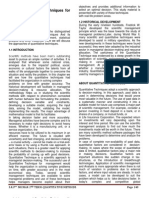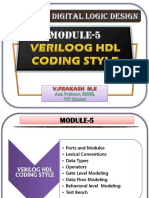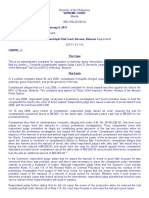MODULE 1 Introduction
Uploaded by
Raven CabreraMODULE 1 Introduction
Uploaded by
Raven CabreraMODULE 1
MANAGEMENT SCIENCE
SESSION TOPIC 1: Introduction of Management Science
LEARNING OUTCOMES:
The following specific learning objectives are expected to be realized at the end of the session:
1. Explain what a Cash Flow Statement is
2. Identify how the Cash Flow Statement is presented and reported
3. Identify the components of a Cash Flow Statement
KEY POINTS
Management Science Quantitative Technique Decision-Making Model
CORE CONTENT
Introduction:
This module covers the discussion of
a. Importance and use of management science
b. Enumerate the steps in applying the decision tools
IN-TEXT ACTIVITY
Management science is the adoption of IBM reported, in 2017, that 90% of the total data
quantitative methods and analytics in decision- as of 2016 were created in the last two years,
making process. referring to year 2015 and 2016.
Management Science is also termed as Imagine that!
quantitative techniques in decision making,
decision analysis, and operational research. That was 2016, it is now 2020, can you imagine
the volume of data and information we create
10 Key Marketing Trends For 2017, an article during 2017 to 2020?
published by IBM, state that the data were so
tremendous that it now important to digest that
information.
We are not computers that can compute and use 2.5billion bytes of data a day. But making sense of the
volume of data, may allow us better understand things – such as, but not limited to, customers’ needs,
wants, and preferences.
This fast and voluminous data creation and technological advancement leads to the Fourth Industrial
Revolution – the fourth industrial revolution refer to large-scale automation of several industries from
manufacturing, service providers and alike. To foster and continue this development, would require
machine-to-machine communication, internet of things, artificial intelligence, and automation. Fourth
industrial revolution needed and was induced primarily by data and information – by big data.
Module 1: Management Science 1
In a business set-up, decision makers should be well-versed in gathering, understanding, and utilizing big
data. More data means more factors to consider making the decision process a more complex function.
We aim that every decision should be logical and with the basis primarily to lessen the possibility of
losses or regrets.
In decision making we can classify data unto two
Quantitative Factors Qualitative Factors
Are data that can be accurately calculated like Are more difficult to quantify but affect the
interest rates, inventory levels, labor cost, cost of decision process like weather, political will,
electricity and demand technological advancement.
Rationale in using quantitative techniques
Variables associated with business decision
The factors that are relevant to the problem they face
The various alternative that are available to them
The logical consequences of the possible alternatives
The best alternative in terms of profits and realization of objectives
In applying management science tools, a decision-maker commonly use the following steps:
Step 1. Formulating and defining the problem, under this step a decision maker must state in a clear and
concise manner the issues to be resolve.
It is said to be the most difficult and important step because it gives direction to the decision-maker of the
succeeding steps.
The common difficulty of this step is the incapability of identifying the issues or that the decision maker
does not know that there is a problem, unless until the symptoms revealed and is late to react.
Module 1: Management Science 2
Example:
You have invested cash to establish a milk-tea store and
probably your objective is to maximize your profit.
Then the next steps of analysis will follow that objective
Step 2. Defining the decision variables and constraint. Identifying
these variables help the decision-maker to develop what tool or
model is appropriate.
Example: Continuing with your Milk-tea Store example, what
products you will offer to maximize the profit?
We identify:
Key decision: How many units of X, Y, and Z are to be produced
Variables: X is notation for a product, (e.g., taro milktea),
Y is symbol use for another product (e.g., fruitea), and
Z is symbol use for another product (e.g., coffee milktea)
Constraint: Limited working hours
Objective: Maximize profit
Using the variables and constraint. The decision maker will have a better understanding and help in
providing solution for the primary objective (problem).
Step 3: Is the creation or developing a suitable model – a mathematical model or a mathematical
representation of the problem. A mathematical model is the form of expression and equations that
replicate the problem.
Example (continuation of previous example) :
Maximum Profit = 2X + 3Y + 4Z
Assuming that each X have 2pesos contribution margin, 3pesos for each
product Y, and 4 pesos in product Z.
Subject to (The constraint)
Working hours = 0.2X + 0.1Y and 0.3Z
Working hours should not be more than 8 hours.
Module 1: Management Science
Assuming that it would require 0.20 hours to make product X, 0.1 hours to 3
make product Y, and 0.3 hours to make the product Z.
A mathematical model requires
Specification of a complete list of variable factors that are relevant to the problem at hand
Specific quantifiable relationships among variables
Step 4: Acquiring the Input Data. The solution for the problem might be formulated and develop from the
previous step, but it cannot provide the optimal or best solution in absence of accurate data. The decision
maker must identify, select, and gather data that represent the variables properly. It is noteworthy, that
misinformation and wrong data can lead to a bad decision.
Step 5. Solving the Model. Is the checking the correctness of the equation used and of the model. The
decision maker should take consideration that processes, or model is properly done.
Step 6. Validating the Model refers to determining how good and realistic the solution is. While validating,
the decision maker identifies the fitness of the model used, its inaccuracies and should take corrective
actions to properly solve the issue.
Step 7. Implementing the Results or the deployment of the solution. This is the actions and the decisions
made by decision-maker.
Advantages of Mathematical Modelling
a. The approach is realistic
b. Models can help the decision maker formulate and expound the problem
c. Models can provide meaningful insights and information
d. The method can save resources, time, money, effort and more.
e. The model can communicate the problems and solutions to decision-makers and others.
Possible Problems in the Quantitative Analysis Approach
1. Defining the problem
o Problems may not be easily identified.
o There may be conflicting viewpoints
o There may be an impact on other departments.
o Beginning assumptions may lead to a particular conclusion.
o The solution may be outdated.
2. Developing a model
o Manager’s perception may not fit a textbook model.
o There is a trade-off between complexity and ease of understanding.
3. Acquiring accurate input data
o Accounting data may not be collected for quantitative problems.
o The validity of the data may be suspect.
4. Developing an appropriate solution
o The mathematics may be hard to understand.
o Having only one answer may be limiting.
Module 1: Management Science 4
5. Testing the solution for validity
o Analyzing the results in terms of the whole organization There may be an institutional
lack of commitment and resistance to change.
o Management may fear the use of formal analysis processes will reduce their decision-
making power.
o Action-oriented managers may want “quick and dirty” techniques.
6. Management support and user involvement are important.
o There may be a lack of commitment by quantitative analysts.
o Analysts should be involved with the problem and care about the solution.
o Analysts should work with users and take their feelings into account.
SESSION SUMMARY
The increase in volume of data and the complexity of transaction, in business parlance, improved the
position of the required usage of data available. In utilizing and understanding the data we can use the
management science – a scientific and quantifiable- approach of solving realistic problem.
The objective of the management science is to make available scientific basis to the decision maker in
order to have a greater degree of control over the outcome of the decision. Several quantitative
techniques are available and each of the technique will best fit to solve the problem or attain the
objectives of the decision maker.
Module 1: Management Science 5
You might also like
- An Overview of Analytics, and AI: Learning Objectives For Chapter 1No ratings yetAn Overview of Analytics, and AI: Learning Objectives For Chapter 123 pages
- National Ecotourism Strategy and Action Plan 2013-2022100% (3)National Ecotourism Strategy and Action Plan 2013-202285 pages
- Chapter 1 - Quantitative Mangement ApproachNo ratings yetChapter 1 - Quantitative Mangement Approach19 pages
- UNIT-1 1.1 Management Science and Quantitative AnalysisNo ratings yetUNIT-1 1.1 Management Science and Quantitative Analysis32 pages
- Decision Making. Singapore: Cengage Learning Asia Pte LTDNo ratings yetDecision Making. Singapore: Cengage Learning Asia Pte LTD7 pages
- CH 1-Ch 3 (Quantitative Mangement Approach)No ratings yetCH 1-Ch 3 (Quantitative Mangement Approach)114 pages
- Chapter One (Quantitative Mangement Approach)No ratings yetChapter One (Quantitative Mangement Approach)33 pages
- 2.1BSA-CY2 - REVERAL, ANGELA R. - EXERCISE#1 - Management ScienceNo ratings yet2.1BSA-CY2 - REVERAL, ANGELA R. - EXERCISE#1 - Management Science3 pages
- Six-Step-Process-for-Resolving-Unstructured-ProblemsNo ratings yetSix-Step-Process-for-Resolving-Unstructured-Problems5 pages
- Opertions Research Note From CH I-V Revised86% (7)Opertions Research Note From CH I-V Revised129 pages
- Opertions Research Note From CH I-V RevisedNo ratings yetOpertions Research Note From CH I-V Revised130 pages
- MAC 421 HO 1.3 Introduction To Management ScienceNo ratings yetMAC 421 HO 1.3 Introduction To Management Science5 pages
- Opertions Research Note From CH I V RevisedNo ratings yetOpertions Research Note From CH I V Revised124 pages
- Enjoy an instant PDF download of the complete Supervision Concepts and Skill-Building 10th Edition Certo Solutions Manual.100% (7)Enjoy an instant PDF download of the complete Supervision Concepts and Skill-Building 10th Edition Certo Solutions Manual.66 pages
- OPERTIONS RESEARCH Note From CH I-V Revised91% (11)OPERTIONS RESEARCH Note From CH I-V Revised145 pages
- PRELIM - L1 - Introduction To Management ScienceNo ratings yetPRELIM - L1 - Introduction To Management Science32 pages
- Supervision Concepts and Skill-Building 10th Edition Certo Solutions Manualinstant download100% (1)Supervision Concepts and Skill-Building 10th Edition Certo Solutions Manualinstant download56 pages
- OPERTIONS RESEARCH Note From CH I V Revised PDF100% (1)OPERTIONS RESEARCH Note From CH I V Revised PDF145 pages
- Decision Making: 1.1 Decision and Decision MakersNo ratings yetDecision Making: 1.1 Decision and Decision Makers13 pages
- Module 2 - Computerized Decision SupportNo ratings yetModule 2 - Computerized Decision Support9 pages
- Opertions Research Note From CH I-V RevisedNo ratings yetOpertions Research Note From CH I-V Revised150 pages
- Chapter 1 Introduction Management - CienceNo ratings yetChapter 1 Introduction Management - Cience55 pages
- Chapter 9 Rizal's Grand Tour of Europe With Viola (1887)No ratings yetChapter 9 Rizal's Grand Tour of Europe With Viola (1887)2 pages
- Chapter 9 Rizal's Grand Tour of Europe With Viola (1887)No ratings yetChapter 9 Rizal's Grand Tour of Europe With Viola (1887)2 pages
- Trends Networks and Critical Thinking in The 21st CenturyNo ratings yetTrends Networks and Critical Thinking in The 21st Century83 pages
- Synopsis On The Prohject Role of Ngos in Enhancing Social Welfare IntoductionNo ratings yetSynopsis On The Prohject Role of Ngos in Enhancing Social Welfare Intoduction5 pages
- Femtocells Technologies and Deployment.9780470742983.51847100% (4)Femtocells Technologies and Deployment.9780470742983.51847329 pages
- Bagaimanakah Beban Kerja Dan Stres Kerja Mempengaruhi Kinerja Karyawan Dengan Burnout Sebagai Variabel MediasiNo ratings yetBagaimanakah Beban Kerja Dan Stres Kerja Mempengaruhi Kinerja Karyawan Dengan Burnout Sebagai Variabel Mediasi14 pages
- Guy Wire Hardware For Set # 1 at Elev 75.00 FTNo ratings yetGuy Wire Hardware For Set # 1 at Elev 75.00 FT1 page
- ELYM 115 2nd Opp Examination MC-2022-09-21 TTNo ratings yetELYM 115 2nd Opp Examination MC-2022-09-21 TT3 pages
- Brochure of Chiang Rai City MunicipalityNo ratings yetBrochure of Chiang Rai City Municipality8 pages
- Conquilla vs. Bernardo, A.M. No. MTJ-09-1737, February 9, 2011No ratings yetConquilla vs. Bernardo, A.M. No. MTJ-09-1737, February 9, 20115 pages
- Norwegian School Geography and Geographical Education - A New Research Field?No ratings yetNorwegian School Geography and Geographical Education - A New Research Field?8 pages
- An Overview of Analytics, and AI: Learning Objectives For Chapter 1An Overview of Analytics, and AI: Learning Objectives For Chapter 1
- National Ecotourism Strategy and Action Plan 2013-2022National Ecotourism Strategy and Action Plan 2013-2022
- UNIT-1 1.1 Management Science and Quantitative AnalysisUNIT-1 1.1 Management Science and Quantitative Analysis
- Decision Making. Singapore: Cengage Learning Asia Pte LTDDecision Making. Singapore: Cengage Learning Asia Pte LTD
- 2.1BSA-CY2 - REVERAL, ANGELA R. - EXERCISE#1 - Management Science2.1BSA-CY2 - REVERAL, ANGELA R. - EXERCISE#1 - Management Science
- Six-Step-Process-for-Resolving-Unstructured-ProblemsSix-Step-Process-for-Resolving-Unstructured-Problems
- Enjoy an instant PDF download of the complete Supervision Concepts and Skill-Building 10th Edition Certo Solutions Manual.Enjoy an instant PDF download of the complete Supervision Concepts and Skill-Building 10th Edition Certo Solutions Manual.
- Supervision Concepts and Skill-Building 10th Edition Certo Solutions Manualinstant downloadSupervision Concepts and Skill-Building 10th Edition Certo Solutions Manualinstant download
- Chapter 9 Rizal's Grand Tour of Europe With Viola (1887)Chapter 9 Rizal's Grand Tour of Europe With Viola (1887)
- Chapter 9 Rizal's Grand Tour of Europe With Viola (1887)Chapter 9 Rizal's Grand Tour of Europe With Viola (1887)
- Trends Networks and Critical Thinking in The 21st CenturyTrends Networks and Critical Thinking in The 21st Century
- Synopsis On The Prohject Role of Ngos in Enhancing Social Welfare IntoductionSynopsis On The Prohject Role of Ngos in Enhancing Social Welfare Intoduction
- Femtocells Technologies and Deployment.9780470742983.51847Femtocells Technologies and Deployment.9780470742983.51847
- Bagaimanakah Beban Kerja Dan Stres Kerja Mempengaruhi Kinerja Karyawan Dengan Burnout Sebagai Variabel MediasiBagaimanakah Beban Kerja Dan Stres Kerja Mempengaruhi Kinerja Karyawan Dengan Burnout Sebagai Variabel Mediasi
- Conquilla vs. Bernardo, A.M. No. MTJ-09-1737, February 9, 2011Conquilla vs. Bernardo, A.M. No. MTJ-09-1737, February 9, 2011
- Norwegian School Geography and Geographical Education - A New Research Field?Norwegian School Geography and Geographical Education - A New Research Field?

































































































